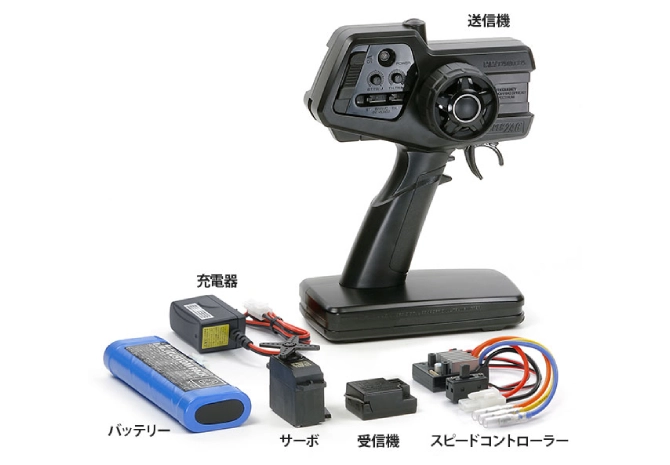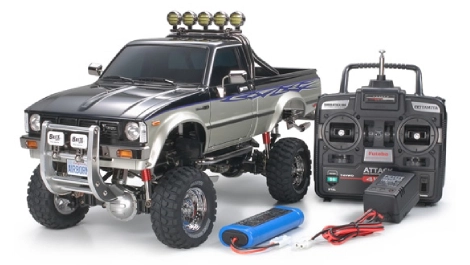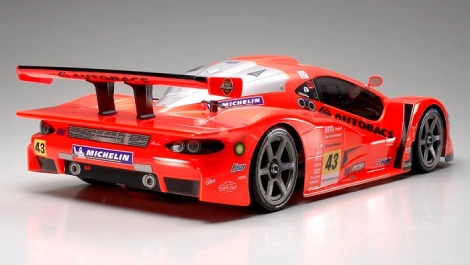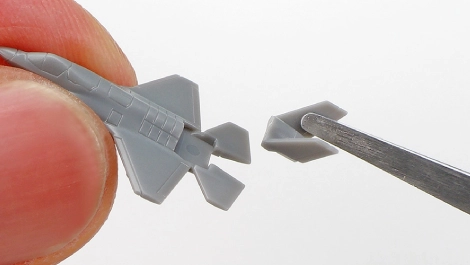Basic knowledge of electric RC cars - Tamiya RC Start Guide
Electric RC cars are easy to enjoy, but also offer a wealth of control techniques and driving performance. They are extremely popular among the many RC models available, and are enjoyed by many users around the world. In this section, we will introduce the mechanisms, control techniques, and setting knowledge of electric RC cars, focusing on on-road touring cars. Please take a look to enjoy a more fulfilling RC hobby.

Types of electric RC cars
Electric RC cars come in a variety of scales, but the mainstream is the 1/10 scale type (total length approximately 45 cm). There are many types of 1/10 scale machines, including formula cars such as F1, touring cars, and off-road types such as buggies , but Tamiya also offers a diverse lineup of other scales, such as the more compact Star Unit series and trailer trucks equipped with a 3-speed transmission that allows gear changes via RC operation while driving . Click
here for a list of all Tamiya RC car series .

R/C and control system
Electric RC cars use 2-channel radio controls, and a set designed specifically for electric RC cars is one that combines a wheeled-type transmitter, one servo, a speed controller, and a receiver. In an RC mechanism with this configuration, the servo changes the direction of the front wheels, and the speed controller controls the rotation of the motor, controlling forward and reverse movement, as well as the speed and stopping.
- Some 2-channel radio control sets for gasoline cars come with a set of two servos, one for steering and one for throttle control, instead of a speed controller.
- For a more detailed explanation of RC systems, please see 2 Basic knowledge of RC systems . 2 ความรู้พื้นฐานของระบบ RC
To run an assembled RC kit, you will need the items shown in the photo. If you are just starting out with RC, it may be a good idea to choose a model that includes all of these RC systems as a set.

How the speed controller works
A speed controller (also known as a speed control amplifier, ESC, amplifier, etc.) electronically adjusts the length of time electricity is sent to the motor to control the speed of the machine. At low speeds, the percentage of time electricity is sent is small, and the higher the speed, the more electricity is sent, and at top speed, electricity is sent all the time. Note that when using a high-powered motor, a speed controller with corresponding specifications is required, so when replacing the motor, you should also check the specifications of the speed controller.
Motor
The most standard motor for electric RC cars is the 540 type. Tamiya also offers many high-performance motors as optional parts, which can be used to significantly improve performance by replacing the standard motor. Electric RC car motors contain consumable parts called
"brushes", but in recent years brushless motors, which do not have these brushes, have become popular. Brushless motors require a dedicated speed controller, but they have the advantage of being durable and have excellent rotational efficiency. For more information on improving performance, please see 07 The Fun of Improving Performance .
Be careful not to drive too long!
Electric RC cars can be driven continuously if you replace the battery, but if you drive continuously for long periods of time, the motor may heat up and performance may decrease. To maintain the performance of the motor, it is recommended that you take a break after using up the battery and allow the motor to cool down sufficiently before driving it again.

The motor is available as an optional part.

Tamiya Brushless Motor 02 15.5T (ITEM 54612)
*Features three connection cords.
Battery and Charger
Batteries are the power source for electric RC cars. Many electric RC cars use rechargeable batteries for their running power, which come in several types, including NiCad, nickel-metal hydride, and lithium-ion, and each is used in conjunction with a corresponding charger. Until now, the type that has been most commonly used as a power source for electric RC cars is the "7.2V NiCad battery," which consists of six 1.2V NiCad batteries connected in series. NiCad batteries are available in two capacities, 1300 and 1600mAh, and the larger the capacity, the longer the running time will be.
View Tamiya's list of RC batteries
Charge the battery after you've finished using it
NiCd batteries can be used hundreds of times if used correctly, but proper care is essential to maintain their performance. The first thing to remember is to "charge the battery after you've finished using it." If you repeatedly charge and use a partially used battery, the battery voltage will gradually drop faster, and even if you charge it, it will not run satisfactorily (this is called the memory effect). The basic way to prevent this is to stop running the RC car after a certain amount of battery consumption, as its running speed will drop rapidly, and you should use this as a guide to stop running and wait a while before charging it. If you want to do it more carefully, you can maintain better condition by properly discharging the battery with a discharger after use, and then waiting for a while (about a day) until the inside of the battery stabilizes before charging it. If the memory effect occurs, you can restore the condition by repeating the above-mentioned appropriate usage cycle several times.
Continuous use also shortens the battery life
NiCad batteries can be damaged if they are used repeatedly in extremely short intervals, such as driving → charging immediately → driving → charging immediately. If you are practicing all day at a circuit, you may have no choice but to recharge the battery on site, but in terms of extending the battery life, it is best to avoid charging the battery multiple times a day.
Use a charger that matches your battery
There are two types of chargers for driving batteries: AC type, which uses a household outlet as a power source, and DC type, which uses a 12V car battery as a power source. A standard charger may be included with the battery, but since the charging time with such a charger is long, we recommend using a quick charger if you are serious about enjoying electric RC cars. The charging time with a quick charger depends on the battery capacity, but it is speedy at about 1 hour for AC types. If you have a lot of batteries, this is an item you should definitely introduce.
- Depending on the model, the charger will support different batteries, such as NiCad only or both NiCad and NiMH. When purchasing an additional charger, be sure to check the compatible batteries carefully.
Check out RC batteries and chargers

7.2V custom pack (NiCd battery) and charger set

Tamiya 7.2V Battery Auto Discharger 2 (ITEM 55097)
Discharger for NiCd and NiMH batteries.

Tamiya 7.2V Nickel-Metal Hydride/NiCad Battery AC Charger NIC-01 (ITEM 55108)
AC rapid charger compatible with both nickel-metal hydride and nickel-cadmium batteries.
LF batteries that support repeated driving and charging are now available
Tamiya's LF battery, which uses lithium ion (Li-ion), is attracting attention as a next-generation driving battery that is different from both nickel-cadmium and nickel-metal hydride batteries. It is characterized by its high energy density, light weight, and excellent safety, and can be used repeatedly more than 1,000 times, exceeding nickel-cadmium and nickel-metal hydride batteries. In addition, there is no memory effect even if the battery is partially used and then recharged, and there is no deterioration in performance even if it is used by repeatedly charging and driving many times in a day. In addition, because it has the characteristic of having little self-discharge, it can be stored for a long time by charging it to about half its capacity, making it a new generation battery that is easy to use not only for advanced users but also for beginners who enjoy driving occasionally.
"Balance charging" is effective when it really matters:
Some chargers for LF batteries are equipped with a function called "balance charging." This function aligns the voltage between each cell that makes up the battery and charges it, and is done using a dedicated connector that is equipped on LF batteries. Balance charging maximizes the performance of the battery, so many people use a balanced-charged battery when it really matters, such as when participating in a race.

LF2200-6.6V Racing Pack (ITEM 55102)


Caution when handling the running battery
RC batteries have a lot of power, and if they are handled incorrectly, they can be dangerous, as a short circuit can cause the cord or the battery itself to catch fire. Please pay close attention to the following:
- When not running, always unplug the chassis battery from the vehicle by unplugging the connector.
- Do not disassemble the chassis battery or cut the cord. This can cause a dangerous short circuit.
- Leaving the insulation on the chassis battery cord torn can cause a short circuit. Do not use the chassis battery and request repairs at Tamiya Customer Service.
- When charging the chassis battery, always use the specified charger and read the instruction manual carefully.
Precautions when driving
- It is dangerous to drive in deep sand, or to try to keep a car moving that has been stuck after a collision, as this will cause the motor to heat up excessively.
Tools, adhesives, paints, etc. required for assembly
If you are going to build the kit as is, you don't need many tools. The kit will also explain how to use glue and paint, but the following items are enough. Even if you purchase a pre-assembled XB series, it is recommended that you prepare tools for maintenance after running.
Tools
Click here for information on how to use the tools. Cutter knife, Phillips screwdriver (large and small), needle-nose pliers, nippers, etc.
Paint
Click here for information on body painting For RC cars, polycarbonate and styrofoam bodies are the mainstream. For polycarbonate bodies, you can paint them with special polycarbonate paint, and for styrofoam bodies, you can paint them with paint for plastic models. For other bodies, prepare the paint listed in the kit.

Craft Tool Series No.85 RC Tool Set of 8 (ITEM 74085)
A set of the main tools required for RC assembly.

Polycarbonate spray ( See the lineup list )
Glue
The type of glue required varies depending on the model, but in the case of RC cars, if you have instant glue to attach hollow rubber tires to wheels, you rarely need any other glue. If there is any other glue that is particularly required, it will be listed in the assembly instructions for the kit.
OP.339 Instant Glue (for Tires) (ITEM 53339) : : Low viscosity type ideal for attaching tires to wheels. 5g, 2 nozzles included .
Oil and Grease
The rotating parts such as gears, shafts, bearings and joints rotate at high speeds when driving. If these rotating parts do not have enough oil and grease, not only will they not move well, but the parts will also wear out quickly. Apply oil or grease to rotating and moving parts according to the instructions in the assembly instructions, and clean them regularly. Make-up material Ceragrease HG (ITEM 87099) : High quality grease used to lubricate moving parts such as gears.

OP.338 Tire Adapter (ITEM 53338)
An adapter that allows for quick attachment of tires and wheels.

Ceragrease HG (ITEM 87099)
High quality grease used to lubricate moving parts such as gears.





